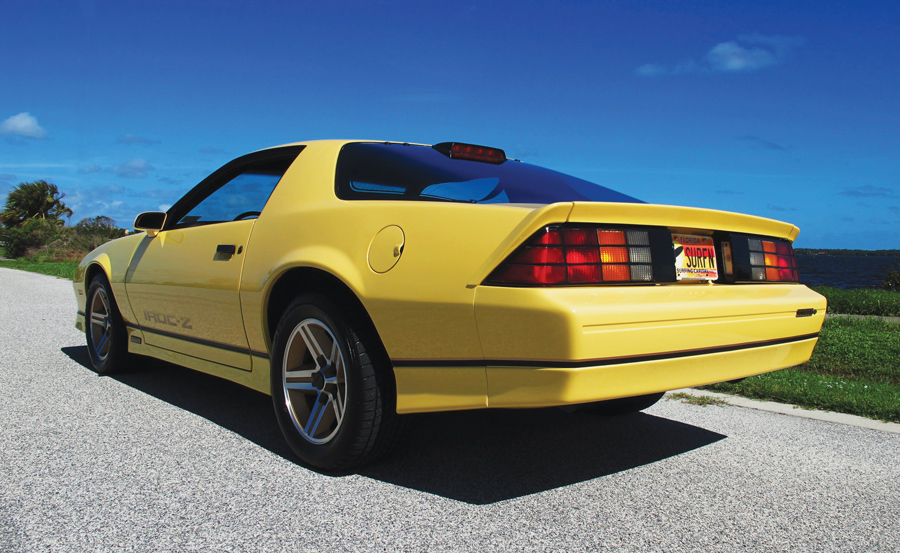- Highly optioned IROC-Z with very low miles
- Outstanding original condition
- 5.0-liter V8 engine with tuned port injection
- Four-speed automatic transmission with overdrive
- Factory T-tops
- Deluxe interior with overhead console
- Air conditioning
SCM Analysis
Detailing
| Vehicle: | 1986 Chevrolet Camaro IROC-Z |
| Years Produced: | 1985–90 (IROC-Z) |
| Number Produced: | 129,688 |
| Original List Price: | $11,719 |
| SCM Valuation: | $14,575 |
| Chassis Number Location: | Driver’s side base of windshield |
| Engine Number Location: | On right-hand front of block under a/c compressor |
| Alternatives: | 1983–86 Ford Mustang 5.0, 1982–87 Pontiac Firebird 5.0, 1996–97 Chevrolet Camaro SS |
| Investment Grade: | C |
This car, Lot F266, sold for $22,500, including buyer’s premium, at Carlisle’s Lakeland Winter auction in Lakeland, FL, held February 21–23, 2020.
The Chevrolet Camaro IROC-Z was designed and built expressly to destroy the Mustang 5.0. But as has always been the case, the two Pony Cars were similar in many ways.
However, the newer Camaro had a few legs up on the Mustang. The Chevy’s sleek body was more aerodynamic than the Ford’s, which had been painstakingly penned during the Carter administration, and the IROC’s interior was far plusher and more modern than that of the Mustang.
Track star
The Camaro’s dominance of the Mustang continued on the track, where the IROC-Z mopped the floor with the Ford.
While the Mustang suffers from excessive body roll, exacerbated by heaps of understeer, the Camaro handles flatly. A dab of additional throttle immediately solves any hint of understeer in the Camaro’s cornering. By comparison, pumping additional fuel into the Mustang’s 5.0-liter V8 only makes matters worse; more power causes the Fox-body ’Stang to grind its front tires even harder.
Despite being better on the track, the Z falls short of the ’Stang in its street manners. The Camaro’s automatic, which most cars had, did the job well enough but wasn’t all that high-performance feeling, while the T-top body was known for flexing when pushed hard, which caused rattles and squeaks.
Worse yet, the Camaro’s twin rear seats were more akin to a luggage shelf than a bench on which you’d expect full-size humans to sit. Meanwhile, the Mustang can comfortably seat a family of four. That is, if the children are still small.
Ultimately, Mustangs and IROC-Zs spent most their time on the street, not on the track. So it makes sense the Ford continued to outsell the Chevy in the arena where it conducted itself more comfortably.
On the upswing
While the enthusiasm for Fox-body Mustangs has ebbed and flowed over the past 40 years, the third-gen Camaro’s following hasn’t. It’s remained relatively low. However, that’s starting to change.
The IROC-Z recently sold at the Carlisle Lakeland Winter auction is a perfect example of the shifting of the tides.
It was listed as having “very low miles” (the odometer shows 23,389 miles) and is in “outstanding original condition.” It was optioned with factory T-tops, deluxe interior with overhead console, and air conditioning. Finished in yellow paint, this IROC-Z is a prime example why the make is finally coming into its own.
When I showed this auction result to my 33-year-old friend who is both a police officer and a new father, he replied: “That seems about right. But, to be fair, I would never have wanted to own an IROC-Z until right about now anyhow.”
I initially laughed off his comment. But it has stuck with me. Like most Pony Car fans, it seems, I had not thought much about the third-gen Camaro — let alone the IROC-Z. But my friend’s interest, albeit mild, wormed its way into my brain. And it got me thinking.
A new world
Like its contemporary, the C4 Corvette, the third-gen Camaro’s styling has sluffed off most of its social baggage (both good and bad) in the last 30 years. Meanwhile, its lines have aged into a fine retro-chic; it’s cool in an ironic way.
By comparison, the Fox-boxy Mustangs look like cheap and dreary economy notchbacks. Sorry, not sorry.
The Camaro, however, appears to have been designed as if it were destined to be featured in the music video of a hair-metal band — one that couldn’t afford to rent a Ferrari 308 for the day. There’s something oddly appealing about that. Add to that the optional T-tops and a shouty paint color and you have yourself a real winner in the looks department.
Rise of the IROC
I doubt that the third-gen Camaro will ever enjoy the popularity the Fox-body Mustang has experienced. But if one third-gen Camaro trim level is destined to rise out of the proverbial collector-market darkness, it’s the IROC-Z.
It has undeniable track-day performance bona fides — after all, it’s named after the International Race of Champions and was bred from new with higher performance over a standard Z. It doesn’t look like virtually anything else on the road today, save the contemporary Firebird, and although they were produced in large numbers, the IROC-Z was still a special-edition model. So it has some extra noteworthiness baked in.
Let me go ahead and warn any prospective buyers: The IROC-Z may have been quicker than the Mustang 5.0 on a track in 1986. However, that doesn’t mean it’s going to be anywhere near as enlivening today by modern automotive standards.
So if you do invest in an IROC-Z, get it with the expectations of enjoying it most while either parked or at a gentle cruising speed. Same goes for the Fox-body Mustang, mind you. But at least the IROC-Z is fun to look at.
Call this one well bought.
(Introductory description courtesy of Carlisle Auctions.)
